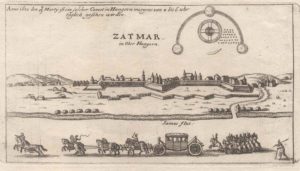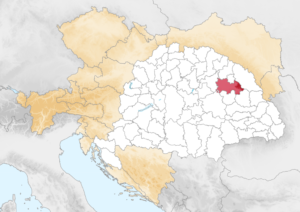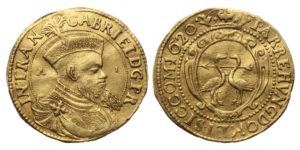Szatmár / Szatmárnémeti

Szatmár / Szatmárnémeti (Satu Mare, Sathmar) is located at the entrance of Transylvania, Romania. Now, the once important Borderland castle of Szatmár is known to us only from the drawings of a few famous Italian architects like the Baldigara brothers: Ottavio and Giulio, or from the work of Cesare Porta. It is not widely known that plenty of late-Renaissance forts were built in the 16th century along the 1,000-mile-long Hungarian / Croatian / Transylvanian Borderland that separated Western Europe from the Ottoman Empire.

Before the Turks arrived, Szatmár had its medieval history just like other Hungarian settlements. In the 11th century, King István (Stephen) of Hungary settled the Teutonic (German) colonists at the periphery of the city (Villa Zotmar), brought in by István’s wife, the Bavarian Queen Gisela of Hungary. The first written mention of Szatmár is from 1150 when the place was called “Zothmar”, presumably, it used to be the name of its first owner. We know that the earthen fortress used to be one of the first Hungarian castles that served as residences to the Comes of the particular County. Szatmár was called a Castrum Regium between 1217 and 1230. It was King András II in 1230 who granted special rights to the Germans living in Szatmár, they were the ones who had come with Queen Gisela.

Later, the inhabitants of the settlement were joined by more German colonists from beyond the Szamos River.
The Mongols destroyed the castle in 1241. However, quite soon the settlement was flourishing again. Due to the economic and commercial benefits, Szatmár became an important center for craft guilds. The city’s importance was linked to the transportation and commerce of salt from nearby Désakna (Ocna Dejului/Salzdorf). We know, that István, son of King Béla IV had a favorite house in Szatmár where he liked to stay in 1261. Later, he became King István V and granted privileges to the inhabitants of Szatmár and to the people who lived in the village of Németi in 1264.
A royal free city since the 13th century, Szatmár changed hands several times. According to the sources, the people living in Németi were the hunters of the king in 1330. In 1411, Szatmár was given to Voivode George Brankovics, the Serbian Despot, in exchange for the town of Nándorfehérvár (Belgrade). We know that there was a castle built by King Matthias Corvinus and it was there around 1460. In the 15th century, until the Báthory family took possession of the castle in 1526, they proceeded to divert the Szamos’ waters to defend the southern part of the citadel; thus, the fortress remained on an island linked to the main roads by three bridges over the Szamos.

After the Defeat of Mohács (1526), Szatmár was the third best-fortified frontier castle of the Kingdom of Hungary, built on its easternmost part. It used to have five bastions. As Szatmár was located on the three-sided border between Royal Hungary, Transylvania, and the Turkish Occupied Lands, its owners were changed between the Transylvanian princes or the Habsburgs during the Ottoman Wars.

King Ferdinand gave Szatmár and the village of Németi to the Báthory family in 1543 who built up the castle on the island of the Szamos river. The castle’s plan was a regular pentagon, with Italian-style bastions at its corners. There were two gates and the soldiers’ buildings as well as the storehouses stood on the large castle yard. Later, the outer defenses were gradually constructed, the earthen ramparts were built on a stone or brick foundation, and a wooden palisade strengthened it. As the area was swampy, the brick and stone foundations were crucial for the construction. Unfortunately, there has never been a larger archeological excavation to reveal the secrets of the long-demolished castle.
King János Zsigmond took it away by a siege and Queen Isabella, widow of King Szapolyai and the mother of János Zsigmond, appointed Balassa Menyhárt as the captain of Szamos castle in 1558. Yet, the new captain instigated his soldiers and took King Ferdinand’s side. János Zsigmond tried to take the castle back with Turkish auxiliary troops but due to the brave resistance of Captain Zay Ferenc, he couldn’t take it. (Please, note that I use the Oriental name order for Hungarians where family names come first.)

Balassa Menyhárt and his men were raiding around Kassa. More precisely, Lord Balassa from Szatmár took all his men and attacked Tokaj castle in the autumn of 1564. He wanted to harvest the famous Tokaj vines. Báthory István, the man of King János Zsigmond was waiting for such an opportunity. He made a surprise attack on the castle of Szatmár and took it on October 3, 1564 (or September 3). He also took the castle of Nagybánya and destroyed the castle of Szatmár. The family members of Lord Balassa were taken prisoners.

According to the Memoria Rerum:

with the help of Báthory András. Their troops set out with a large army to take the castle back in 1565. Báthory István saw them coming and he set the fort on fire and fled. You can read more about Lazarus Schwendi here:
https://www.hungarianottomanwars.com/essays/general-schwendi-in-royal-hungary-a-german-hero/
Austrian general Lazar Schwendi ordered the citadel to be rebuilt after the plans of Italian architect Ottavio Baldigara; using an Italian system of fortifications, the new structure would be pentagonal with five towers. Szatmár was modernized by Italian military engineers and architects, and it became the center of the Trans-Tisza River Region. It was opposing the Transylvanian Principality which was about to be born. General Basta in 1603 ordered the Italian Cesare Porta to complete the reconstruction of the fort. Nevertheless, it was occupied by Prince Bocskai the next year. Prince Bethlen got hold of it in 1622, according to the Peace of Nikolsburg.

At that time, Szatmár had a large Jewish community. The presence of Jewish people in Transylvania was first mentioned in the late 16th century. In the 17th century, Prince Bethlen Gábor permitted Sephardi Jews from Turkey to settle in the Transylvanian capital Gyulafehérvár (Alba Iulia) in 1623. As for the Jewish community, the reign of Prince Bethlen (1613-1629) was a milestone not only because he invited more of them into the Principality from abroad but he also declared their privileges in 1623.

Indeed, the Patent issued by Bethlen was exceptional in Christian Europe. The Jewish people were given the right to practice their faith, trade, and settle without restrictions anywhere in Transylvania, without having to wear distinctive marks, and could enjoy legal independence. It was quite different in the Habsburg-ruled Royal Hungary at that time where they didn’t have such rights. Most importantly, Bethlen confronted contemporary thinking and declared in writing that the Jewish community could not be made collectively responsible for faults committed by its individual members.

Prince Rákóczi I György’s armies were attacking the castle of Szatmár rather successfully in 1645, unlike the Turk armies in 1660 and 1663. We also know about a Polish raid against Szatmár in 1657. The town came under Ottoman control in 1661. Called Sokmar by the new authorities, it was a so-called “kaza” center within the Şenköy sanjak of Varat Eyalet.
The fort returned to Emperor Leopold who ordered the noblemen of the region to feed the fort’s German garrison in 1668. It was such a heavy tax that during the next year, the Hungarian noblemen were instigated by a lady called Lónyai Anna and they ambushed the castle, taking it.

Prince Apafi tried to take it with a combined army of 24,000 Wallachian, Hungarian, and Turkish soldiers in 1680 but he couldn’t. Two years later Prince Thököly Imre took it and kept it for two years. The Austrians took the fort back in 1691. It was Prince Rákóczi Ferenc II who ordered the demolishing of Szatmár castle in 1705 and in 1706 but his orders were not obeyed. Finally, it was General Károlyi Sándor who had the castle burned in 1711.
Before these events, Szatmár and Németi (Mintiu) had been two distinct entities. The two settlements “Szatmár” and “Németi”, gradually united their administration between 1712 and 1715, and the resulting city was named “Szatmár-Németi”.

Dear Readers, I can only make this content available through small donations or by selling my books or T-shirts.
If you like my writings, please feel free to support me with a coffee here:
You can check out my books on Amazon or Draft2Digital, they are available in hardcover, paperback, or ebook:
https://www.amazon.com/dp/198020490X or at https://books2read.com/b/boYd81

My work can also be followed and supported on Patreon: Become a Patron!http://Become a Patron!





